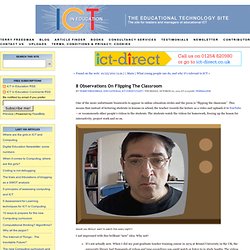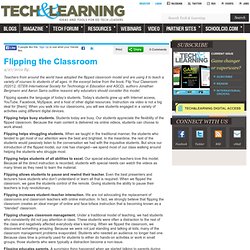

What Is The Role Of Content In Flipped Classrooms? In a flipped classroom, students ‘attend’ the lesson outside of the classroom, typically in the form of teacher presentation videos or animated slide shows that can be viewed online, and in more sophisticated instances, followed by some diagnostic tests to indicate the progress of each student in the understanding of the material presented in that lesson.

The intent is for students to know enough of the topic (to be taught in class) and, having reflected adequately on the ideas they encountered at home, return to class with questions to clarify their understanding. The benefits of a flipped classroom are progressively recognized and relatively well-documented (Fulton, 2012; Bergmann & Sams, 2013; Bergmann 2011; Ash, 2012). In its ideal state, a flipped classroom can transform the learning experience of students. Why Flip? Flipped Learning Explained Visually. Flipping the Classroom - Simply Speaking. Flipteaching. Flipped Class Network - A professional learning community for teachers using vodcasting in the classroom.
How A Flipped Classroom Actually Works [Interview] What happens when the students have more control in the classroom? Flipped classrooms are being tested out around the world and we’ve featured a few examples in case you wanted to see who is flippin’ out. Until now, we didn’t have an in-depth look at the effects of a flipped classroom or answers to the big questions it raises. Thanks to Susan Murphy of Algonquin College (check out her awesome blog suzemuse.com !)
, we have our answers. She was kind enough to answer some of my questions about her experiences flipping her classroom. She used the flipped classroom model for her First Year Video and Audio Production class which is part of the Interactive Multimedia Developer program. What inspired you to use the flipped classroom model? One of the big challenges I was having in my video production class was teaching the required software (Adobe Premiere Pro). I wasn’t sure if it was going to work – but I had to give it a shot! I have had a lot of great feedback on the class. 8 Observations on flipping the classroom. One of the more unfortunate buzzwords to appear in online education circles and the press is “flipping the classroom”.

This means that instead of lecturing students in lessons in school, the teacher records the lecture as a video and uploads it to YouTube – or recommends other people’s videos to the students. The students watch the videos for homework, freeing up the lesson for interactivity, project work and so on. Would you REALLY want to watch this every night?! I not impressed with this brilliant “new” idea. Why not? It’s not actually new. In my opinion, the most brilliant thing about flipping the classroom is how well it illustrates that often when you examine in detail a so-called great idea you find that it’s not so wonderful after all.
The Flipped Classroom: Turning the Traditional Classroom on its Head. To Flip Or Not Flip? To flip or not to flip? That is not the essential question. In assessing the optimal classroom dynamics, I would argue that we need to take a good look at what our classrooms look like right now, what activities our students gain the most from, what we wished we had more time for, and what things about our class we wish we could eliminate. Do I flip: yes. Would I recommend it: enthusiastically. But let’s start by rewinding for a minute, to my 2009 AP Calculus class. Running Out Of Time Worst of all, I felt that I never got to hear from my students because they were trying their best to digest the newly presented material.
So I asked myself the same questions that I posed at the beginning of this essay: what is working, what is not, and what do I wish I had more time for? Planning. Flipping the Classroom. 4/27/2012 By: Teachers from around the world have adopted the flipped classroom model and are using it to teach a variety of courses to students of all ages.

In the excerpt below from the book, Flip Your Classroom (©2012, ISTE® International Society for Technology in Education and ASCD), authors Jonathan Bergmann and Aaron Sams outline reasons why educators should consider this model. Flipping speaks the language of today’s students. Today’s students grew up with Internet access, YouTube, Facebook, MySpace, and a host of other digital resources.